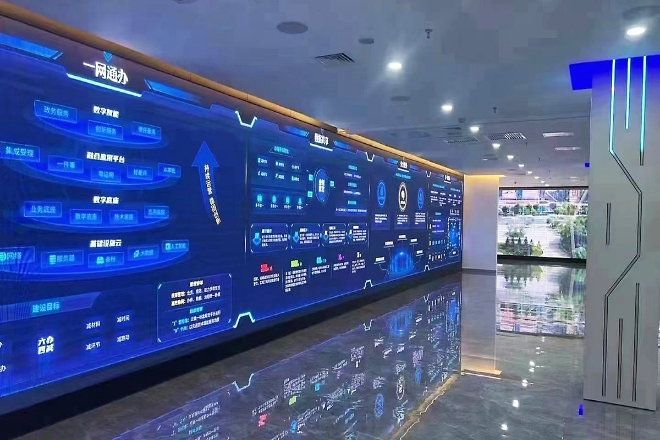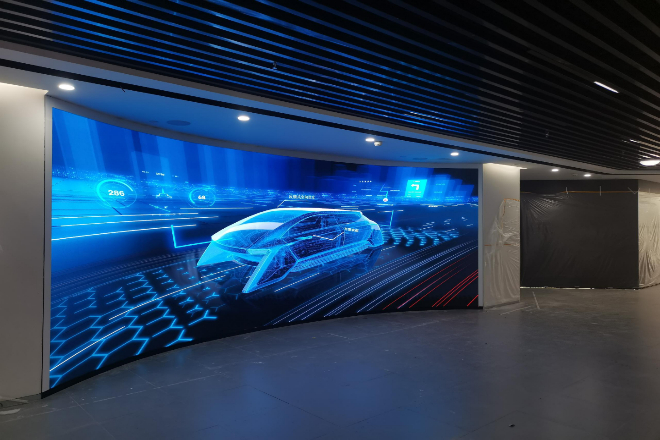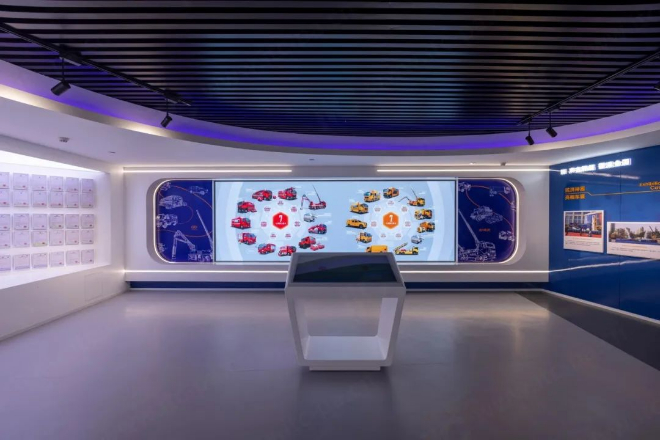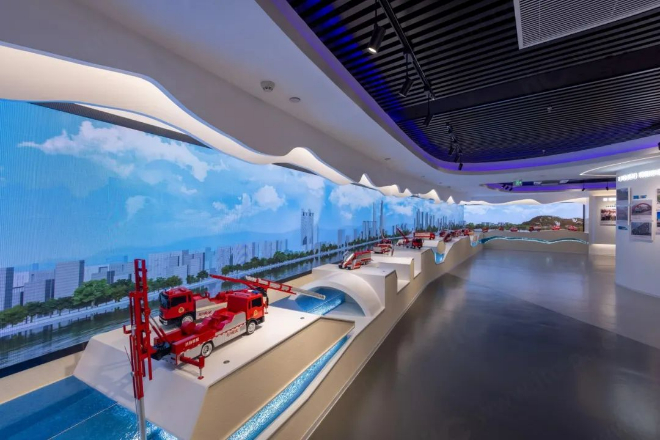Introduction

LED display screens, as display devices integrating high technology, high brightness, and high definition, play an increasingly important role in exhibition hall design, and they have unique advantages.
So, do you know about the various application schemes of LED display screens in exhibition halls? Don’t worry, this article will show you!
Application 1: As a dynamic display panel

The product display area can be used as a dynamic display panel to demonstrate the functions, characteristics, and usage scenarios of the product through videos or animations so that the audience can understand the advantages and value of the product more intuitively.
In the brand promotion area, large LED display screens can play corporate promotional videos and advertisements to enhance brand image and popularity.
At the same time, LED display screens can also be used to publish exhibition hall activity arrangements, guide information, safety tips, etc., providing audiences with convenient information acquisition channels.
In the art exhibition area, LED display screens are also a display platform for digital artworks, bringing a new artistic experience to the audience.
During the implementation process, we first need to conduct a demand analysis, clarify the exhibition hall’s display needs and target audience groups, and determine the specifications, sizes, and installation locations of LED display screens.
Then, according to the results of the demand analysis, select the appropriate LED display brand and model, consider the resolution, brightness, refresh rate, and other key parameters of the display, and ensure that the display needs are met.
Then, the LED display will be installed and constructed according to the design drawings and installation specifications, and the debugging and testing will be completed to ensure normal operation and optimal display effect.
In addition, we also need to produce display content that matches the theme of the exhibition hall, including images, videos, animations, etc., and update the display content regularly to keep it fresh and attractive. Finally, the LED display must be cleaned and inspected regularly to ensure its normal operation and extend its service life.
Application 2: Combine VR technology to create an immersive virtual experience
In exhibition halls, LED displays are usually used as display platforms for playing high-quality videos, images, animations, and other content. When LED displays are combined with VR technology, their display effect will be qualitatively improved.
By wearing VR equipment, the audience can experience the virtual world immersively and interact deeply with the display content as if they were in a brand new, fantasy-filled space.
Specifically, the application of the combination of LED displays and VR technology in exhibition halls can be reflected in the following aspects:
1). Immersive virtual scene display:
Using VR technology, you can create virtual scenes that are completely different from the real world.
For example, through VR technology, the audience can “walk into” the ruins of an ancient civilization, observe cultural relics up close, and even participate in the simulation of historical events.
LED display screens can serve as a visual extension of virtual scenes, displaying more background information, detailed descriptions, or interactive prompts to enhance the audience’s sense of immersion.
2). Multi-sensory experience integration:
In addition to vision and hearing, VR technology can also combine other sensory experiences, such as touch, smell, etc., to provide the audience with a full range of immersive experiences.
LED display screens can be used as auxiliary display tools to help the audience better understand and feel the virtual scene by playing corresponding sound effects, animations, or text descriptions.
3). Customized display solutions:
Different VR display content and LED display display solutions can be customized according to different exhibition themes and target audience groups.
For example, for science and technology exhibitions, futuristic virtual scenes and interactive links can be designed; for cultural exhibitions, historical scenes can be reproduced to let the audience feel the charm of traditional culture.
In practical applications, the combination of LED display and VR technology needs to take into account factors such as the compatibility of hardware devices, the stability of the software platform, and the audience’s experience.
At the same time, in order to ensure the smoothness and realism of the display effect, the VR content and the LED display content need to be carefully designed and optimized.
Application 3: As a multimedia interactive wall

As a multimedia interactive wall, the application of LED displays in exhibition halls has significant advantages. First of all, its high resolution and bright colors can present delicate and realistic images and videos, bringing visual shock to the audience.
At the same time, the brightness of the LED display is adjustable, which can adapt to the display needs under different light environments and ensure the clarity of the display content.
In the application of multimedia interactive walls, LED display is not only a static display platform but also a dynamic and interactive medium. By integrating sensors, touch screens, or other interactive devices, the audience can interact with the content on the LED display in real time.
This interactive method not only enhances the audience’s sense of participation but also makes the display content more vivid and interesting and easier to attract the audience’s attention.
Specifically, the application of LED display as a multimedia interactive wall in exhibition halls can be reflected in the following aspects:
1). Information display and inquiry:
LED display screens can display the exhibition hall’s guide information, event arrangements, exhibit introductions, and other content in real time, providing visitors with a convenient information inquiry channel.
The audience can interact with the LED display screen through technologies such as touch screens or gesture recognition to query the information they are interested in.
2). Interactive games and entertainment:
Using the multimedia characteristics of LED display screens, various interactive games and entertainment projects can be designed, such as touch games, somatosensory games, etc.
By participating in these games and entertainment projects, the audience can increase their stay time in the exhibition hall and enhance the fun and attractiveness of the exhibition.
3). Artwork and creative design display:
LED display screens can be used as a display platform for digital artworks, displaying innovative art forms such as dynamic paintings and digital sculptures.
Designers can use the flexibility and programmability of LED display screens to create unique visual effects and bring a new artistic experience to the audience.
4). Product demonstration and experience:
In the product display area, LED display screens can be used as multimedia interactive walls to display the functions, characteristics, and usage scenarios of products.
By interacting with LED display screens, the audience can more intuitively understand the advantages and value of the products and enhance the display effect of the products.
In order to achieve the best effect of an LED display screen as a multimedia interactive wall, multiple factors need to be considered during the design and implementation process. First, the size and installation location of the LED display screen should be reasonably planned according to the spatial layout and display requirements of the exhibition hall.
Secondly, high-quality LED display screens and interactive devices should be selected to ensure the clarity of the display content and the stability of interactivity.
Finally, the interactive content and interaction methods should be carefully designed to coordinate with the theme and atmosphere of the exhibition hall and enhance the overall experience of the audience.
Application 4: As a creative art installation
As a creative art installation, the application of LED display screens in exhibition halls shows a unique charm.
First of all, the high brightness, high contrast, and high color saturation of LED display screens enable them to present extremely delicate and vivid images, providing a broad imagination space for artistic creation.
Artists can use this feature to create works of art with strong visual impact to attract the audience’s attention.
Secondly, the flexibility and programmability of LED display screens make it an ideal carrier for realizing complex artistic ideas. Artists can design LED display screen art installations of various shapes and sizes and dynamic effects according to the theme and atmosphere of the exhibition.
Specifically, the application of LED display screens as creative art installations in exhibition halls can be reflected in the following aspects:
1). Dynamic art display:
Using the dynamic display characteristics of LED display screens, artists can create works of art with a time dimension. These works can change over time, showing different visual effects and artistic conceptions.
When watching these dynamic works of art, the audience can feel the passage of time and the evolution of art, thus gaining a richer aesthetic experience.
2). Interactive art installations:
LED display screens can be combined with interactive devices such as sensors and touch screens to form interactive art installations. The audience can interact with the installations through touch, sound, action, etc., to change its display content and effects.
This interactive method enhances the audience’s sense of participation and immersion, making the art installations more vivid and interesting and more likely to resonate with and interest the audience.
3). Environmental art integration:
LED display screens can be used as part of environmental art, integrated with the architecture, decoration, and other elements of the exhibition hall to create a specific atmosphere and theme.
Through careful design and layout, LED display screens can form a harmonious unity with the surrounding environment, enhancing the overall effect and viewing of the exhibition.
In order to achieve the best effect of LED display screens as creative art installations, artists and designers need to fully consider the theme, atmosphere, and needs and expectations of the exhibition.
They need to carefully design the shape, size, dynamic effects, and interactive methods of the LED display screen to ensure that it is coordinated with the overall style and theme of the exhibition. At the same time, they also need to select high-quality LED displays and interactive devices to ensure the stability and reliability of the art installation.
Application 5: As an information display device

As an information display device, the application advantages of LED displays in exhibition halls are significant. First, it’s high brightness and high definition ensure that the information can be clearly seen under any lighting conditions。
Whether it is bright daytime or dim night, it can maintain a good display effect. Secondly, the large viewing angle characteristics of the LED display screen allow information to be seen by more viewers at the same time, without crowding or queuing, which improves the efficiency of viewing the exhibition.
Specifically, the application of LED displays as information display devices in exhibition halls can be reflected in the following aspects:
1). Exhibition guide information display:
The LED display screen can display the exhibition guide map, exhibition area distribution, exhibit introduction, and other information in real time to help the audience quickly understand the overall layout and key content of the exhibition.
Through dynamic updates, the LED display screen can also release the latest developments, event arrangements, etc., of the exhibition in a timely manner to ensure that the audience obtains the most accurate information.
2). Detailed display of exhibit information:
For each exhibit, the LED display can display detailed information, including name, author, creation year, material, size, and the story behind it.
This detailed display method not only improves the audience’s understanding of the exhibits but also increases the attractiveness and viewing value of the exhibits.
3). Multi-language information support:
In an international exhibition hall, the LED display can support information display in multiple languages to meet the needs of audiences from different countries and regions.
By switching language settings, the audience can easily obtain information in the language they understand, which improves the convenience and comfort of viewing the exhibition.
4). Dynamic data and information display:
LED display can also be used to display dynamic data and information, such as audience flow, exhibition popularity, and exhibit popularity.
These data can provide real-time feedback to exhibition hall managers, helping them to better understand the operation of the exhibition and make corresponding adjustments and optimizations.
In the implementation process, in order to ensure the best effect of the LED display as an information display device, the following factors need to be considered:
Content design: The information content should be concise and clear, avoid being too complicated or lengthy, and ensure that the audience can quickly obtain key information.
Update frequency: According to the needs of the exhibition and the needs of the audience, the frequency of information updates should be reasonably set to ensure the timeliness and accuracy of the information.
Equipment maintenance: Regularly maintain and inspect the LED display to ensure its normal operation and good display effect.
Interactive considerations: Where possible, consider adding interactive elements such as touch screens or voice recognition to enable the audience to obtain information more actively.
Conclusion
In summary, there are many application solutions for LED displays in exhibition halls, whether it is basic information display and video playback, innovative interactive experience, art installations, virtual reality, etc., which fully demonstrates its unique charm and unlimited possibilities.
Finally, if you want to know more about LED displays, please get in touch with us.
